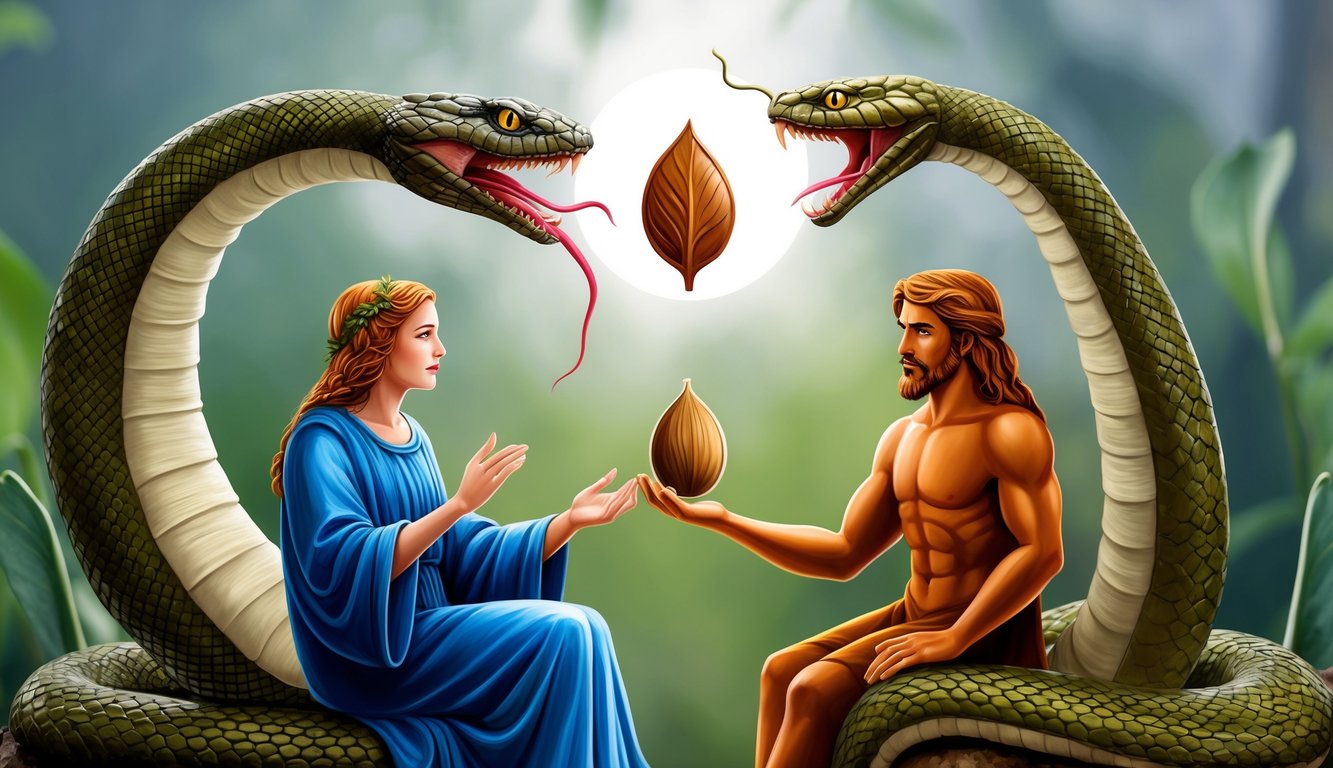Don’t Miss Out On This Unique Astrological Opportunity
Are you tired of spinning your wheels and getting nowhere? Simply put, you’re out of sync: you’re out of alignment with your astral configuration.
But: there’s a kind of map that can help you reclaim your alignment. Think of it as your own personal blueprint to success and happiness: a blueprint that will help you live your most amazing life.
Get started here.
Genesis 3:15 is a verse that stands out as one of the most crucial prophetic scriptures in the Bible.
It speaks about the conflict between the serpent and the woman’s offspring, symbolically representing the battle between good and evil. This passage foretells the victory of the Messiah over the serpent, promising that he will crush its head even if his heel is bruised. This prediction is significant because it lays the groundwork for understanding the mission and purpose of Jesus Christ throughout the New Testament.
In many translations like the NIV, ESV, KJV, and others, this verse is recognized as the first hint of salvation’s promise.
It’s not just a story of conflict; it’s about hope and redemption.
The literal meanings and symbols invite readers to explore deeper theological questions about good triumphing over evil, sparking curiosity and encouraging dialogue among theologians and believers alike.
This verse continues to intrigue because of its layered meanings and its impacts on Christian beliefs.
Genesis 3:15 also connects with other parts of the Scripture, highlighting the need for a Savior and the ultimate sacrifice.
By weaving this verse into the broader narrative of the Bible, you’re invited to consider its lasting influence on Christian faith and understanding.
The rich history and cultural significance of this verse make it an essential piece of any biblical study, offering both comfort and insight.
Key Takeaways
- Genesis 3:15 prophesizes the victory of the Messiah over evil.
- The verse acts as a foundational promise of salvation.
- It connects deeply with Christian themes and beliefs about redemption.
The Significance of Genesis 3:15
Genesis 3:15 is often seen as a pivotal verse in the Bible because it carries a remarkable prophecy about the conflict that would continue between good and evil.
It introduces the idea of a promised Redeemer who is part of God’s plan for salvation.
Prophetic Interpretations
Genesis 3:15 is often referred to as the “protoevangelium,” meaning “first gospel.” This verse marks the Bible’s initial announcement of a promised Savior. The “seed” in this verse refers to a future descendant of the woman, who will ultimately defeat evil.
Some believe that this prophecy points directly to Jesus Christ, who is seen as the promised Redeemer.
The imagery of the “bruise” and “crush” is thought to symbolize Jesus’ victory over sin and Satan’s temporary harm to Him.
This interpretation connects to many messianic prophecies, such as those found in Isaiah and the New Testament books like Matthew and Galatians.
These connections create a consistent narrative of hope and redemption throughout the Bible.
Literary Analysis
From a literary perspective, Genesis 3:15 plays a crucial role in shaping themes throughout the Bible.
The verse introduces the ongoing battle between the forces of good and evil. The “enmity” mentioned signifies the conflict between Satan and humanity.
This conflict is seen through the dual imagery of “head” and “heel,” representing the eventual crushing of evil and the struggles faced along the way.
Meanwhile, the terms “seed,” “offspring,” and “enmity” carry symbolic weight.
They emphasize the importance of lineage and divine intervention.
This literary element serves as a foundation for later biblical narratives and highlights the significance of spiritual warfare in the Christian faith.
Theological Insights and Interpretations
Genesis 3:15 is a key scripture that highlights the ongoing conflict between good and evil.
It sets the stage for the story of redemption as promised by God.
The verse touches on themes such as enmity, hope, sin, and grace, giving clues about humanity’s struggle and God’s plan for salvation.
Themes of Redemption and Grace
In Genesis 3:15, the promise of redemption emerges.
Even amid the curse following the fall, there is hope.
God speaks of enmity between the serpent and the woman’s offspring, suggesting a conflict that will end with the defeat of evil.
This is viewed by many as the first hint of the coming Savior.
You see a glimpse of God’s grace, as He lays out a plan for salvation despite human sin.
This enmity reaches forward to the New Testament, where Jesus’ life and sacrifice are seen as the ultimate fulfillment of this promise.
Redemption and grace offer hope that God will restore what was lost through sin.
Consequences of the Fall
The fall brings severe consequences, changing human nature deeply.
Sin, once introduced, leads to separation from God and an introduction of death and suffering.
Genesis 3:15 points to the enduring impact of this event on humanity.
You experience the perennial struggle against temptation and sin as part of human existence.
The promise in the verse also hints at future redemption and transformation for fallen humanity.
The enmity remains a constant reminder of this divide and the need for divine intervention to overcome the power of sin for salvation.
Connections to Christ and New Testament

Genesis 3:15 is often seen as a prophecy that points directly to Jesus Christ’s role in defeating evil.
This verse creates an expectation of a Redeemer, depicted as a descendant of Adam and Eve, fulfilling promises made throughout scripture.
Christ’s Victory Over Evil
In Genesis 3:15, the defeat of the serpent is symbolic of Christ’s triumph over sin and evil.
This idea is reinforced in the New Testament.
In 1 John 3:8, it says, “The Son of God appeared to destroy the works of the devil.” This underscores Christ’s mission to bring redemption.
Colossians 2:15 emphasizes this victory, stating that through the cross, Christ disarmed spiritual powers.
Meanwhile, Hebrews 2:14 highlights that Jesus, by his death, destroyed the devil’s power over death.
This establishes Jesus not only as a descendant or seed but as the promised Messiah who fulfills the prophecy of defeating sin for humanity’s sake.
Historical and Cultural Context

In examining Genesis 3:15, it’s crucial to consider it within its historical and cultural setting to understand its significance.
The Old Testament reflects the life and beliefs of the Ancient Near Eastern world, and the story of Eden holds symbolic value in this backdrop.
Ancient Near Eastern Worldview
The cultural context of Genesis is deeply tied to the Ancient Near East.
The region was filled with rich mythology and stories, much like the account of Adam and Eve.
This setting was heavily influenced by themes of creation and divine laws.
Temptation and the figure of the serpent were not unique to Genesis.
In various cultures, serpents often symbolized trickery and knowledge.
The serpent’s role in the Garden connects these wider myths with the Hebrew understanding of disobedience and divine punishment.
This narrative reveals the shift from creation’s harmony to toil and struggle.
Life in Eden and the Ancient World
Life in Eden depicted an ideal existence with Adam and Eve having freedom, permission to enjoy the garden, and a balance in their relationship with nature.
The story contrasts deeply with the toil and challenges in the broader ancient world.
The Genesis story is a part of a universal history aiming to explain human struggle.
After the fall, Adam was sentenced to toil the ground, and Eve faced pain in childbearing.
Their lives reflected the hardships that were all too familiar to the people of that time.
This narrative has been explored through various interpretations, including the Greek version and Jewish Targums like Jonathan and Jerusalem, further emphasizing its importance and reach.
Frequently Asked Questions

Genesis 3:15 is packed with themes like the conflict between good and evil and the redemption story.
It hints at deep meanings that many find intriguing and important in biblical study.
What is the interpretation of the ‘bruising of the heel’ mentioned in Genesis 3:15?
The “bruising of the heel” often represents the harm or suffering experienced by the woman’s offspring.
This suffering is seen as temporary compared to the ultimate destruction of the serpent.
It hints at the struggle but not a lasting defeat.
Can you explain the enmity mentioned between the serpent and the woman in Genesis 3:15?
The enmity describes a lasting conflict between the serpent (often seen as representing evil) and the woman’s offspring.
This struggle symbolizes the ongoing battle between good and evil.
It signifies a foundational tension in spiritual teachings.
How is Genesis 3:15 considered a messianic prophecy?
Genesis 3:15 is often viewed as the first mention of the coming of a Savior.
The verse hints at Jesus’s eventual victory over evil.
The “he will crush your head” part is seen by many as a prediction of Christ’s triumph over sin and Satan.
What promise or hope is found within the passage of Genesis 3:15?
Hope is found in the promise of victory over evil.
The passage promises that the serpent’s power will be defeated.
It offers assurance of a future triumph and redemption beyond the immediate struggles and pain.
In what way does Genesis 3:15 connect to the overall theme of redemption in the Bible?
The verse lays the groundwork for the Bible’s central redemption story.
It foreshadows the coming of a redeemer who will restore humanity.
This connection to redemption provides a foundation for understanding the narrative of salvation in biblical texts.
Could you describe the historical significance of Genesis 3:15 in biblical theology?
Genesis 3:15 holds a crucial place in biblical theology.
It is often considered as the “protoevangelium” or first gospel, marking the introduction of God’s plan for salvation.
Its historical significance lies in its early foreshadowing of a coming savior and the promise of victory over evil.
This verse establishes the ongoing conflict between the serpent and the offspring of the woman, ultimately pointing to Christ’s victory over sin and death.
Many theologians see this as an early hint of God’s redemptive plan, which unfolds throughout Scripture and finds its fulfillment in Jesus Christ.
While Genesis 3:15 does not explicitly mention the trinity in the Bible, it lays the groundwork for understanding God’s triune nature in the unfolding story of redemption.



